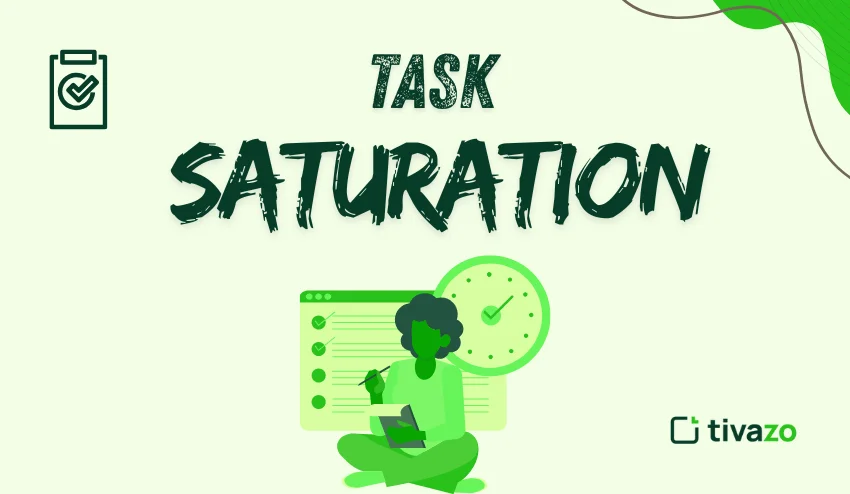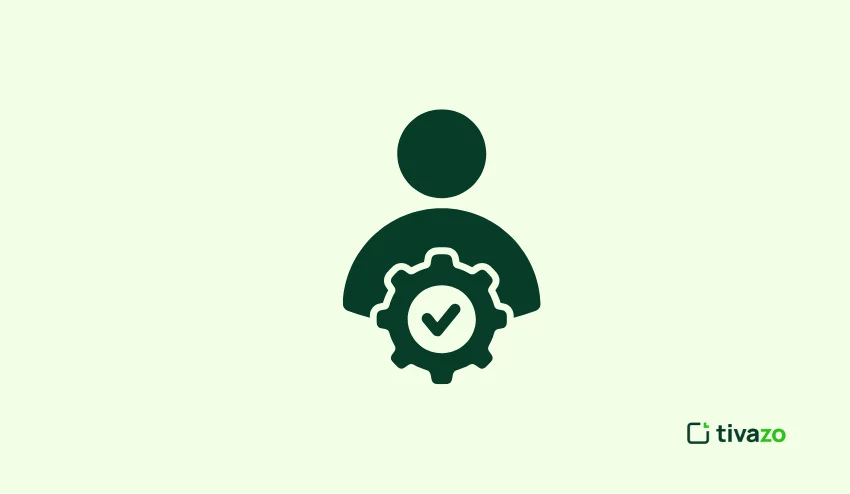It has almost become a badge of honor to be overwhelmed with too much work in today’s busy and demanding world. However, when demands outweigh your cognitive ability, you open yourself to a very small, but potentially dangerous area called task saturation. In this blog article, we will define task saturation, provide real-world examples of task saturation, identify causes and impacts, and share some practical strategies (especially designed for teams) to help avoid or manage task saturation.
Regardless of whether you are an individual with too many priorities for tasks or a manager who is trying to help increase the productivity of the entire team, understanding task saturation and how to manage it is a pathway to help regain focus, efficiency, and performance.
Task Saturation
Task saturation is a state where there are demands, whether in number, complexity, or pace, on a person (or team) that exceed their ability to efficiently process, evaluate, and complete those demands. To put this in simpler terms: there is too much to do and not enough time, mental bandwidth, or resources to do it all.
From a previous NBAA Safety Committee Task Saturation white paper: “too much to do without sufficient time, tools, or resources to do it.” Experts also discuss task saturation as a type of cognitive overload – when there is more information, decisions, or tasks than your brain can handle. It’s not just being busy; it is being so busy that your effectiveness, accuracy, or attention starts to wane.
When task saturation occurs at work, there may be missed deadlines or careless mistakes. Or it may simply look like not being able to prioritize effectively. Task saturation can affect anyone from front-line workers to senior executives, and can quietly undermine productivity, creativity, and decision quality. Recognizing the warning signs early is the first step to managing that experience and mitigating the potential for burnout, fatigue, or disengagement.
How do we best define task saturation?
We can define the characteristics of task saturation more precisely:
- Excess demands: Task requests, decision requests, or information requests exceed the available capacity.
- Limits of time or bandwidth: There is insufficient time or mental capacity available.
- Reduced performance: As saturation increases, performance degrades as indicated by increased errors, attention “tunneling“, or complete shutdown.
- Delayed awareness: Task saturation is typically “creeping” and doesn’t present itself until performance is significantly degraded.
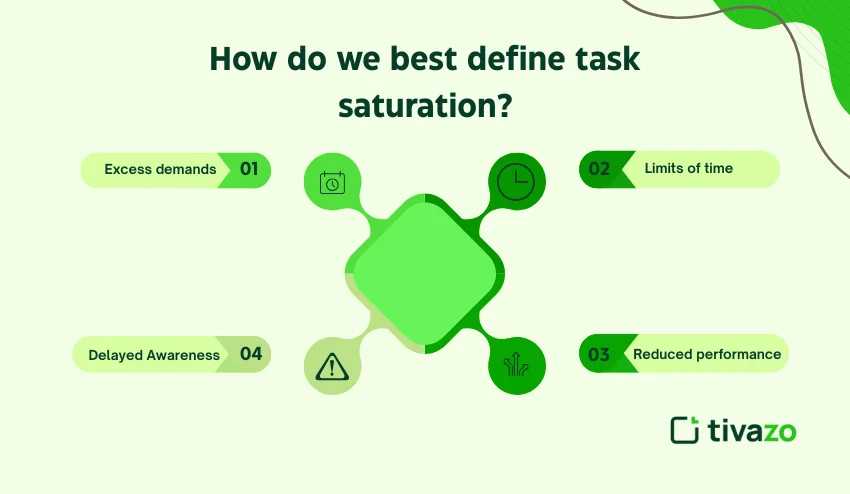
So, we can define task saturation as either cognitive, temporal, or resource demands that exceed capacity and result in reduced performance, impaired decision-making, or an increased risk of error.
Example of Task Saturation in the Workplace
| Scenario | Description | Impact/Error | Key Insight |
| Overloaded Marketing Manager | The marketing manager is managing several campaigns, analyzing data, replying to messages, participating in meetings, and overseeing a team, all within compressed timelines. | Uploads outdated creative assets, provides inaccurate metrics, or misses important client communication. | Too many competing tasks divided the marketing manager’s attention, and unnecessary mistakes ensued. |
| Overloaded Project Manager | High volume of project work, keeping the right project teams working and organized, and accommodating ongoing updates from stakeholders | Missed deadlines, uncertainty about communication, or ownership of tasks. | Capacity became overloaded, and the executive lost clarity when trying to prioritize competing needs. |
| Overloaded Customer Support Agent | A large number of tickets, also switching platforms, responding to internal messages, multiple escalations, and all happening at once. | No timely response or incorrect information was communicated to the customer. | Too much task switching created agenda fatigue and room for error. |
| Overloaded HR Executive | Recruitment, employee relations, compliance reports, processing payroll, and more. | HR may miss important documentation due to the overload of admin requirements or may not meet compliance timelines. | Too many administrative tasks can lead to missing critical responsibilities. |
| Overloaded Team Leader | Working on multiple meetings, reviewing submissions, and processing performance reports, all while being constantly interrupted. | The team leader might forget to follow up on part of the meeting discussion or may even miss signals that the team is burning out. | Excessive work demands on a team leader create cognitive overload that decreases their leadership attributes. |
The main point to remember is that in all office roles, saturating someone’s capacity with tasks will contribute to deteriorating performance, not because of stupidity, but because the volume and urgency of demands were beyond the confines of human limitations. Paying attention to these early signals can reduce costly mistakes and support a healthier and more productive workspace.
Reasons for Task Saturation
Task saturation rarely happens for just one reason. The following are the most common reasons for task saturation:
1. Volume Overload
The most basic reason for saturation is this: There are just too many tasks. When new demands come in at a faster rate than we can process, saturation sets in.
2. Complexity & Novelty
Tasks that are complicated, unfamiliar, or unpredictable will consume increased mental resources. Uncertainty or ongoing changing conditions will worsen the level of load.
3. Time Pressure / Urgency
Tight deadlines or urgent demands drive speed, eliminate slack to think, and increase cognitive stress.
4. Insufficient Resources / Support
If there are not sufficient people, tools, clarity, or delegation in place, then the burden concentrates on too few.
5. Multitasking & Frequent Interruptions
Rapid task switching or interruption can erode efficiency and increase cognitive load.
6. Poor Planning / Prioritization
Poor planning or a lack of priority means tasks compete for attention without any order, creating further chaos.
7. Human Factors & Stress
Physiological stress, fatigue, emotional strain, and overload of sensory input can greatly diminish capacity.
8. Progressive / Rapid overload types
Researchers have described task saturation as rapid overload (i.e., an unexpected burst) or progressive overload (i.e., gradual escalation over time).
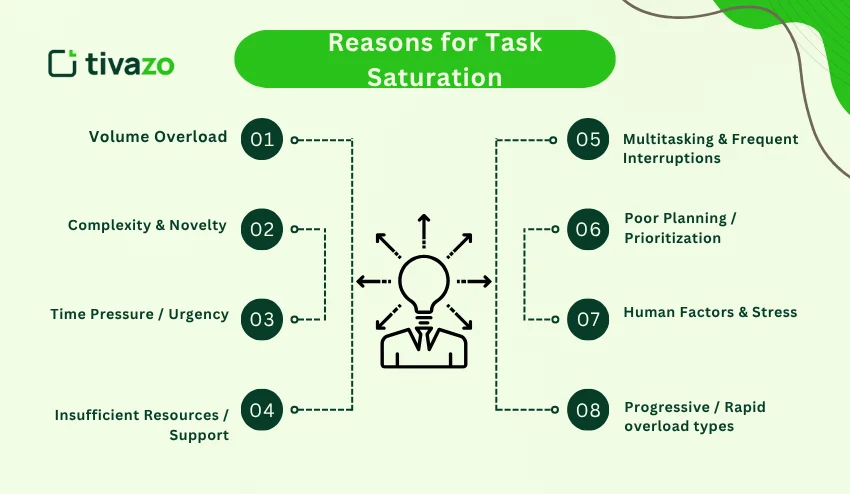
What Are the 4 Types of Saturation?
Saturation is categorized differently depending on the context. In our context (task saturation/cognitive overflow), one way we can think of the saturation problem is through four levels of saturation (some of which are analogous representations from across similarly named concepts). While not universally established in the literature, here is one way to classify it:
1. Cognitive Saturation
Too many decisions or decisions, memory, or mental processing are coped with at once.
2. Temporal Saturation
Time limited all tasks to compete against the limited time.
3. Resource/Capacity Saturation
A need for more tools, people, or support to complete all outcomes.
4. Emotional/Stress Saturation
Emotional stress, fatigue, or pressure is the limiting factor.
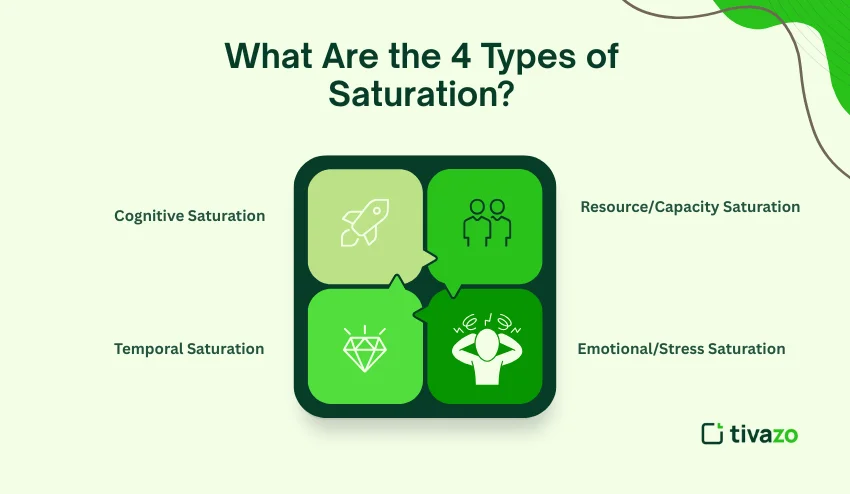
Impacts of Task Saturation
Task saturation carries significant consequences with respect to performance, safety, and well-being. Task saturation adversely affects performance in several ways:
| Impact | Definition |
| Decreased performance/errors | Error levels climb, decisions may be faulty, and time may be lost in forgetting or overlooking the completion of tasks. |
| Loss of situational awareness | Task saturation can lead you to miss critical cues, fail to follow the changing context, and misinterpret signals. |
| Tunnel vision/fixation | One often fixates, focusing on a small set of tasks, ignoring everything else, even if it is critical to their safety/operation. |
| Cognitive lockup/freeze | An individual may simply “go blank,” “freeze” on one problem where they can’t recall information, or move to another task (or tasks). |
| Task shedding/skipping | Anyone observing someone who is saturated may notice that he/she drops or simply ignores a series of tasks, even ones that are more salient but have exceeded his/her span of capacity. |
How to Avoid and Manage Task Saturation
This is a comprehensive and actionable framework for both you and the teams you lead to proactively prevent and manage task saturation.
1. Proactive Planning (“Start the Fight Before the Fight”)
Identify phases or points at which you think task saturation could occur. Then, as you have planned, preemptively consider “What if?” for the contingencies you have considered above.
2. Clear Priority & “Bucket” Metaphor
Think of your tasks being dumped into a mental “bucket.” From the bottom to the top, fill the bucket with tasks of priority. The “musts” fill the bottom of the “bucket,” then the next most important task…get rid of the “nice-to-have” and consider doing it later.
3. Task Shedding/Reduction
When you start feeling saturated, intentionally drop (or even suggest you transfer) tasks that could be considered not essential. This is not laziness… it is survival.
4. Delegation/Mutual Support
When workloads are shared across the team and one person becomes task-saturated, another person provides support or transfers to another team member.
5. Checklists and Standard Operating Procedures
Already identified pre-defined processes help lower mental overhead and help avoid forgetting processes or tasks you have already prepared when you become task-saturated.
6. “Cross-check” or “Attitude Indicator” Checks
In a way of having a regular moment to “cross-check” your tasks with the priority. Maybe a chart you made, if you can see at a glance one or two tasks might be “mission-critical” to be accomplished.
- Burnout & stress-related issues. As with poor performance, things become chronic. Saturation leads to mental fatigue, emotional fatigue, and loss of resilience.
- Team breakdown/coordination error. If they are missing handoffs, communication will be fragile if one (or multiple) members are saturated.
7. Execution Gap Meetings (X-Gaps) / Short Intervals
Stop for a moment in order to realign, evaluate outstanding tasks, redistribute, and adjust priorities.
8. Time Boxing, Chunking, & Buffer Times
Pin down fixed units or “boxes” for execution, include buffer times, and avoid overcommitting. Chunk large tasks into more discrete tasks.
9. Manage Interruptions & Context Switching
Reduce unplanned interruptions. Disable noncritical alerts that distract during the deep-dive experience. Switch tasks on purpose, not instinctively.
10 . Stress & Cognitive Load Management
Ensure you get enough rest, breaks, and brain resets, and track your stress levels. Fatigue reduces the threshold for saturation.
11. Training & Simulation
In high-stakes environments, simulate overload, create a training response, develop mental resilience, and train to shed tasks in the moment.
12. Debrief & Continuous Improvement
After high loads of activity, take time to review what became saturated, what strategies were useful, and improve the operational plan for next time.
Tips for Action / Implementation for Teams / Organizations
- Workshop & Awareness-Session: Take the time to teach your team what task saturation is, its symptoms, and how to hedge its effects.
- Define Saturation thresholds & Triggers: Establish trigger points (e.g., number of tasks pending, alerts per minute) that will initiate mitigating actions (i.e., drop tasks, pause, refocus laborers).
- Create Standard Operating Playbooks: Develop clerical processes, prioritization frameworks, and handoff protocols to ease cognitive load.
- Establish Mutual Support Norms: Encourage cross-checking, or handing off, sharing workloads, or backup roles.
- Create “Task Saturation Drills.” Occasionally, simulate overloads to the session train, maintaining strength while under pressure
- Regular Execution Gap Review: Tracks shorts to course deepen into entire team strategies for rebalancing tasks.
- Monitor Ongoing Feedback & Metrics: Assess missed or errors, team stress (or qualitative) levels post-merge time frame.
- Encourage Boundaries Recovery Time: Promote resetting cognitive capacity and individual breaks to clear deeper access to cognitive capacity (e.g., don’t practice the ceremony of working overload, it harms).
- Iterate Policies & Processes: Iterate both policies and processes for what worked, and what broke under duress.
- Attempt to Lead by Example: Leaders must draw limits and yield commitments when saturating- if leaders are boundlessly committed, eventually it becomes the culture.
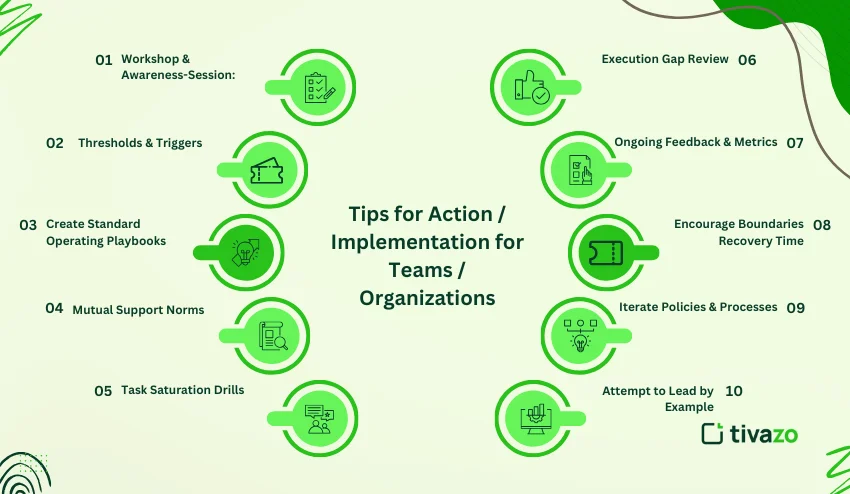
Conclusion
Workplace task saturation is a mute productivity killer. Employees only have so much capacity to complete tasks, make decisions, or experience interruptions. When a good worker exceeds their cognitive capacity, mistakes, deadlines being missed, and frustration are inevitable. The capacity issue at this point is not a skill issue or an effort issue; even highly capable workers become vulnerable once fully taxed.
Once identified, and with causation understood, we can help workers and teams regain control of their work. Taking time to prioritize work, delegate, shed tasks, and implement work processes can help individuals and teams feel back in control of their work. By being a little proactive in organizing workload and cognitive bandwidth, employees can tend to the issues of mistakes, allocate energy more efficiently, and sustain a positive mental well-being. Everyone wins when taking a mindful approach to work so that people can be effective in a sustainable and healthy climate.
